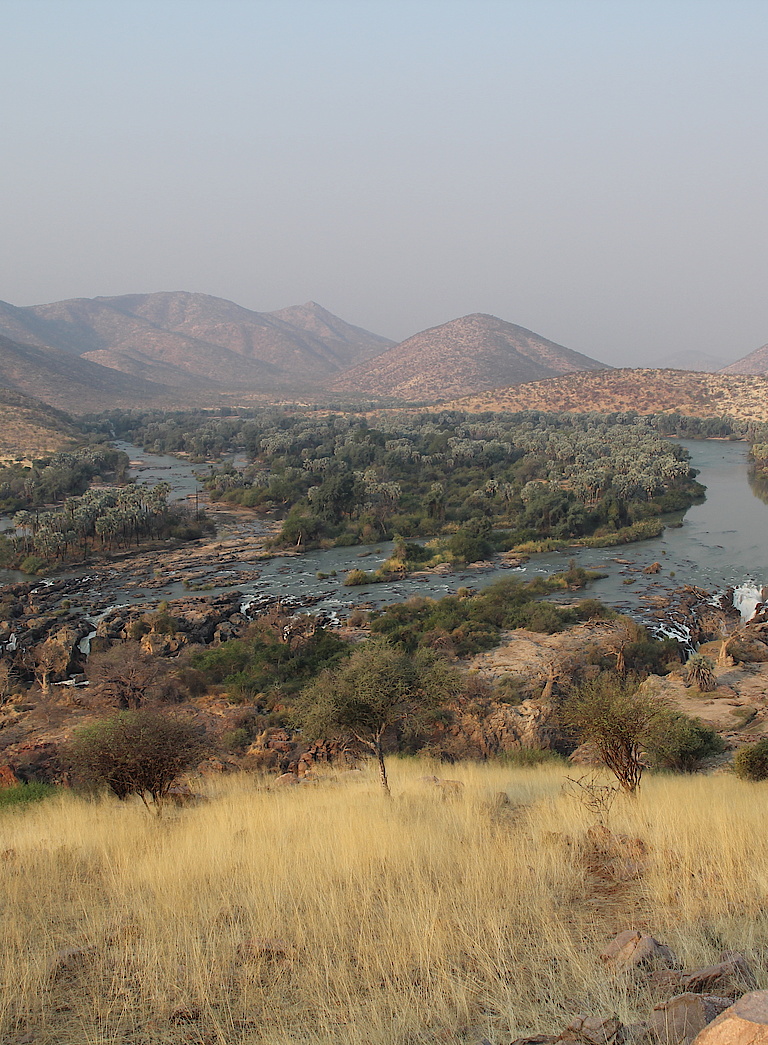PROJECT / TIME OF INTERVENTION
A: ABS Capacity Development Initiative – partner country since 2008, supported though GIZ-BMCC 1 (2011-2015), GIZ-BMCC 2 (2015 -2020) and GIZ CCIU (from 2021)
B: ABioSA - regional intervention country 02/2018- 12/2024
C: Bio Innovation Africa (BIA) - 07/2019 – 12/2025
Why Namibia?
Long standing partner country of BMZ in Natural Resources Management, and Climate Change. Unique Biodiversity and Ecosystems. Advanced community and resource governance systems. Leading country in negotiating the Nagoya Protocol, experiences in establishing benefit-sharing agreements.
Namibia offers a remarkable variety of biomes. These range from extremely arid desert areas (including the oldest desert in the world), to wet savannahs (sub-tropical) areas. It is a dryland country internationally recognised for its biodiversity “hotspots”. Namibia, through its constitution implores the state to ensure sustainable management of biodiversity. Natural resource-based sectors including mining, fisheries, agriculture, and tourism are the basis of the Namibian economy. Around 70 percent of Namibia’s population is directly dependent on the natural resource base for income, food, medicinal and health needs, fuel, and shelter. The high level of species richness and endemism is a national asset and a significant global treasure. This situation demands that biodiversity, and the ecosystem services it provides, are conserved and/or maintained, for sustainable development.
Namibia is recognised as a global leader in conservation and nature-based sustainable development. Its state-run Community-Based Natural Resource Management Programme (CBNRM) is a successful example of decentralising natural resource management and recognising the rights and development needs of local, rural communities. The CBNRM Programme is the main reason behind an overall expansion of land area under conservation management. CBNRM land comprises the largest share of land under conservation in Namibia. Forty-five percent of Namibia’s conservation estate is protected under the CBNRM designation, while 38% is protected under a formal state protected areas designation. Namibia’s CBNRM programme successfully intersects sustainable use with biodiversity and wildlife conservation, human well-being, livelihoods enhancement, and poverty reduction.
Adjustments in the policy and legal framework have transferred rights over fauna and flora to organised Community-based Natural Resource Management (CBNRM) groups (Conservancies and Community Forests) in Namibia’s most marginalised rural areas.
Namibia is a multi-cultural society with a high level of traditional and local knowledge of wild foods, and medicinal plants, and natural resources based remedies. Many of Namibia’s indigenous plants, traditionally used for food, medicine, oils and other products, are now being promoted on a commercial basis. Namibia’s most successfully commercialised indigenous natural products include those derived from devil’s claw, marula and commiphora. New applications are being developed from common plants from which active ingredients were unknown.
Since 2000 Namibian stakeholders have developed with the the Indigenous Plant Task Team (IPTT) an innovative coordinated national “pipeline approach” to proactively creating sustainable economic opportunities based on harvesting, processing and trading indigenous plants and natural products. Although it is estimated that indigenous plant-based products currently only contribute about 5% to GDP through the export of raw materials or ingredients, there is considerable scope for this to be expanded to the benefit of rural communities across the country. Challenge remain; namely, to improve the primary producers’ benefits from the successful marketing of biodiversity-based products, entrepreneurial development of communities and SMMEs, and export and market readiness of companies and their projects. Appropriated financing mechanisms to deal with the latter aggravate the situation.
Political commitment towards sustainable development through natural resource management was invigorated. The “ABS Act” was promulgated in 2017 and entered into force on 1 November 2021 through the gazettement its ensuing regulations. ABS compliance now preempts all natural resources policies and legal frameworks. Further support towards ABS compliance comes from the implementation of various private standards, notably the Good Agricultural and Processing Plus Guidelines for devil’s claw, good manufacturing practices, and UEBT on ethical biotrade. The Competent National Authority (CNA) is based in the Office of the Environmental Commissioner, called the “ABS Office”.
Equally, the private sector’s institutional capacities to promote biodiversity conservation and sustainable use of natural resources were strengthened through, for example, the Namibia Network of the Health and Cosmetics industry (NANCi) and the Namibia Devil’s Claw Exporters Association Trust (NDCEAT), as well as numerous NGOs supporting both community based organisations and business support organisations.
Aims and objectives
ABS Capacity Development Initiative: The overall aim of the ABS Capacity Development Initiative’s work in Namibia is to support the implementation of the Nagoya Protocol in all its dimensions.
AbioSA: Strengthening market access and regional collaboration of the Namibian natural product sector
Bio Innovation Africa has the following objectives in Namibia:
- Requirements for implementation of the national regulations on access and benefit-sharing are improved.
- Mechanisms for using the benefit-sharing scheme for biodiversity conservation measures have been developed.
- Market potentials of selected biodiversity-based value chains are being used.
The above initiatives, programmes and projects are additionally supported by the Climate Change and Inclusive Use (CCIU) project, the EU-SADC Economic Partnership Agreement Implementation Support (EPA) project and the Biodiversity Economy project.
Further details
Video: Marula value chains in northern Namibia
This short film shows the traditional marula harvest in northern Namibia. The members of the Eudafano Women's Cooperative (a BioInnovation Africa partner organisation) collect and process the marula fruits to produce marula oil which is sold on national and international markets. Watch the French version of the video here.
